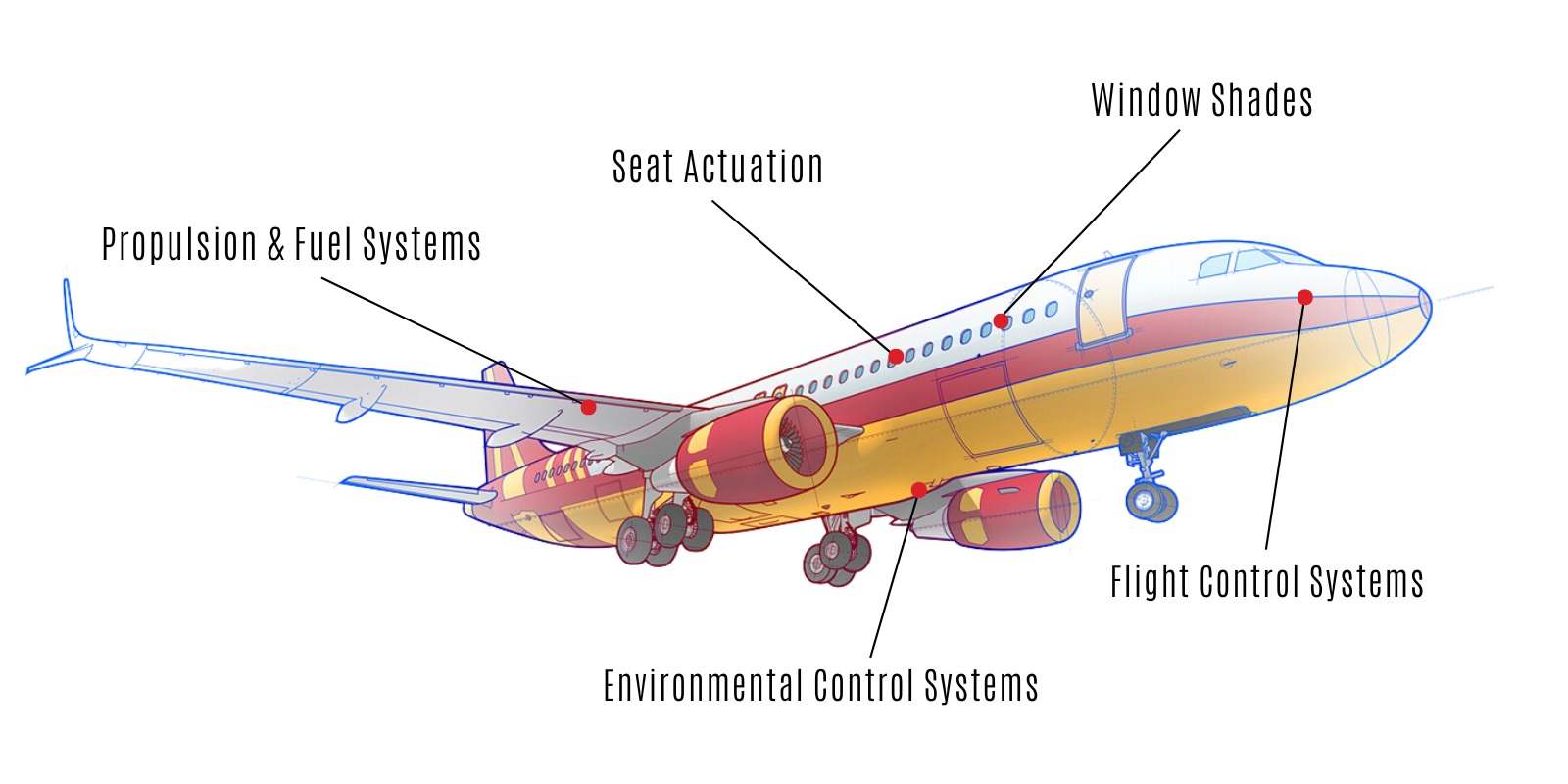Engineering precision miniature motors for advanced aerospace and defence systems

Above:
Examples of miniature motor applications for commercial aeroplanes.
Copyright Portescap
Whilst the aerospace and defence industries continuously evolve, the harsh conditions encountered by their demanding applications remain constant.
Precision miniature motor manufacturers supplying these sectors strive to provide new levels of accuracy, performance, compactness and reliability against extreme temperatures and harsh vibrations. To provide mission-critical motion solutions for commercial airliners, military aircraft and smart munitions, a motor supplier must offer a tailored selection of technologies.

Above:
Examples of Valve Actuation, Environmental Control Systems and Fuel Valve Control Applications.
Copyright Portescap
The challenges of taking to the air
Requiring extremely precise and power-dense miniature motor solutions, aerospace and defence applications present many challenges for design engineers. Temperatures vary immensely, ranging between -55°C to 200°C, with aircraft facing repeated thermal cycles. Take-off, launch, flight and landing incur high shock loads and vibrations – meaning that motor reliability is crucial, as even small movements of the coils can cause damage. All of these factors must be accommodated while ensuring a lightweight, efficient design that provides the utmost reliability and performance.
Fortunately, there are solutions. Temperature variations can be addressed with advanced materials, such as metals in motor housings, special bearing lubricants, custom coatings for electronics and plastic coil insulation. To prevent movement during vibrations and shocks, critical internal components like the rotor, shaft and bearings, along with connected gearboxes and encoders, need to be adequately secured.
Motor technologies for airborne applications
Three primary motor technologies for precision aerospace and defence applications are brushed DC coreless, brushless DC (BLDC) and stepper motors. Both DC coreless and BLDC offer higher efficiencies and lower weight but BLDC motors can be specified either cylindrical or flat with slotted and slotless winding technologies. Where precision is required but price-to-performance is important, stepper motors make an ideal selection.
However, the variance of equipment in aerospace and defence mandates a high level of miniature motor specialisation. Not only do certain designs excel in different applications but they also require specific customisations to meet operational demands.
Solutions for all aircraft types
Valves and actuators are vital components of any military or commercial aircraft, performing critical functions such as flight control, managing airflow into the cabin and regulating fuel flow.
Due to their position on the aircraft, these devices are repeatedly exposed to an extreme range of temperatures. To reliably accommodate this, miniature motors can utilise special magnet material that does not lose its strength over the temperature range. Additionally, custom motor lamination material can be specified to meet a wide range of conditions. Selection of lead wires, which connect the motor to other systems, can be tailored to be pliable in the cold and resist melting under heat.
Current and legacy valve designs tend to use stepper motors to finely regulate position, or brushed DC motors for on/off functionality. However, next-generation smart actuation applications are adopting BLDC motors due to precision positioning, data monitoring capabilities and the availability of maintenance information.

Above:
Window Shade and Seat Actuation applications.
Copyright Portescap
For commercial aircraft, electromechanical control of window shades and seating is becoming commonplace. To achieve this, DC coreless motors are used. With no control electronics, they provide value, while their high efficiency and lightweight characteristics are ideal for saving power as well as reducing fuel consumption, which are all big benefits for an airline.
Guided miniature motor selection
Smart munitions like missiles and guided bombs are one time use, yet precision motion solutions must deliver ultimate performance for exact control of wing deployment, actuation, thrust vectoring and EO/IR guidance systems. In all cases, every motor design parameter could affect overall combat effectiveness and precise payload delivery in this high-speed, extreme vibration application.
BLDC designs are particularly suitable for fin control actuation, thanks to high-power density and small size. All reduce the weight of the system, improving dynamic response and enabling excellent flight control. With regards to wing deployment, brushed DC and BLDC motors are both good options. A compact footprint is especially important for EO/IR applications, with DC and BLDC slotless motors providing big power in a small package to keep the system compact. Brushed DC motors can be useful in this regard too, as they only need basic control electronics, which take up less space.
Generally, for simple motion systems where cost-effectiveness is important, brushed DC motors are the best option. As complexity increases, a fully customised BLDC motor is more likely to be the optimum solution.
Advancing with aerospace and defence
Whether providing precise control for a high-speed missile or reliably accommodating the repeated thermal cycles of a commercial airliner – miniature motors vary greatly across the aerospace and defence industries. Consequently, builders of aircraft require that motor suppliers offer a range of technologies to meet exacting applications.











